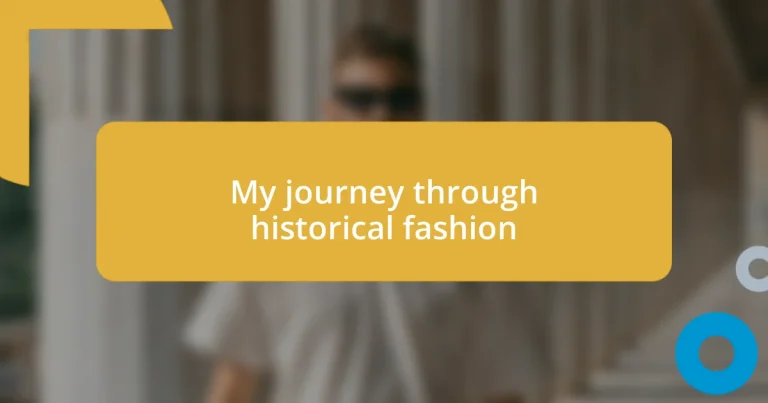Key takeaways:
- Historical fashion reflects cultural shifts and societal norms, embodying narratives of identity, innovation, and rebellion.
- Fashion trends are influenced by significant events (like wars), pop culture, and technology, showcasing society’s values and adaptability.
- Modern interpretations of historical styles foster creativity and cultural dialogue, allowing individuals to blend past influences with contemporary fashion.
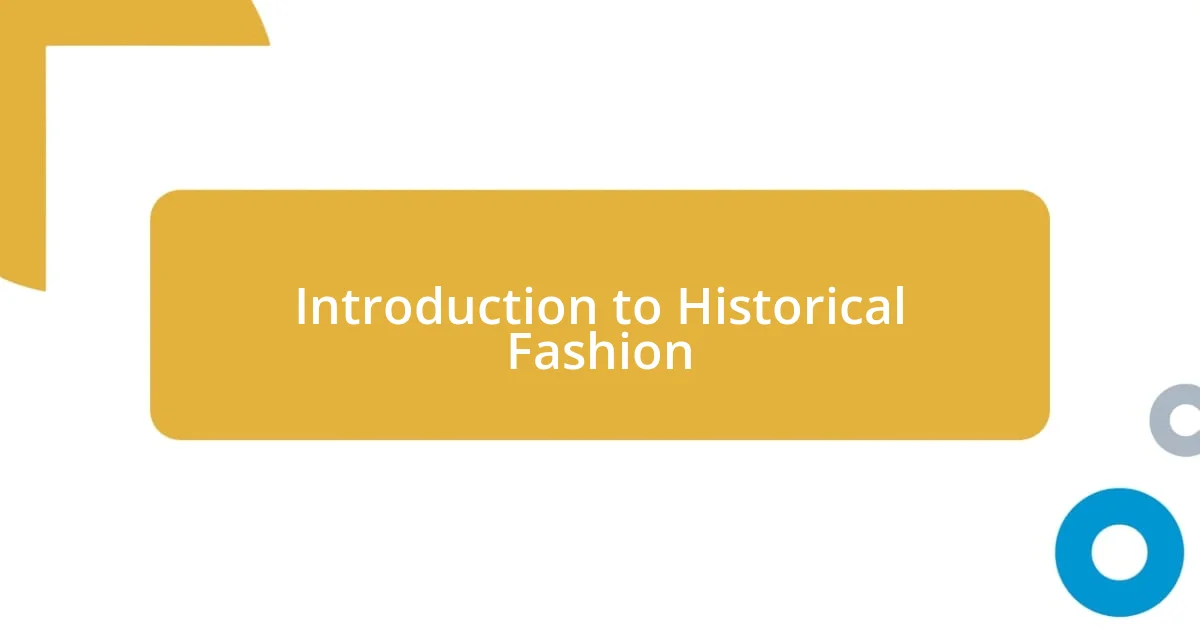
Introduction to Historical Fashion
Historical fashion is like a time capsule, offering us glimpses into the past through the garments worn by those who lived in different eras. I still remember the first time I tried on a Victorian dress; the layered fabrics and intricate lace transported me back in time, making me wonder how women felt navigating their daily lives in such elaborate attire. Isn’t it fascinating how clothes can reflect cultural shifts and societal norms?
As I delved deeper, I realized that fashion history is not just about aesthetics—it’s a narrative of identity, innovation, and sometimes, rebellion. For instance, when the roaring twenties introduced flapper dresses, it was a bold statement about women’s liberation and social change. How empowering it must have felt for women to break away from the constraints of their predecessors!
Exploring historical fashion allows us to appreciate the craftsmanship involved and the stories woven into each piece. I think about how a corset not only shaped women’s silhouettes but also influenced their social standing during certain periods. Have you ever stopped to consider how these fashion choices shaped the lives of those who wore them?
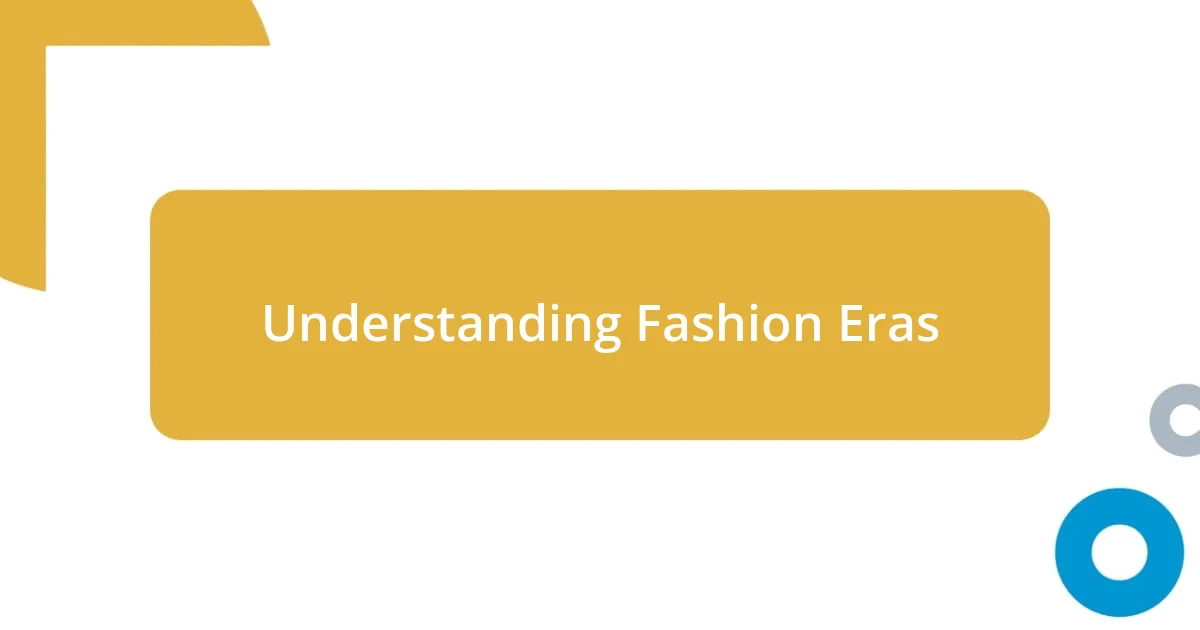
Understanding Fashion Eras
Understanding fashion eras means appreciating how each period tells its own story through style. For me, flipping through a vintage fashion magazine is like opening a time portal, revealing not only the trends but the emotions and social climates of those years. Each era has distinct characteristics, like how the structured silhouettes of the 1950s echoed a post-war desire for order, or how the 1970s embraced free-spirited patterns that mirrored a shift towards individuality and self-expression.
- The Victorian era focused on modesty, featuring corsets and layers that conveyed societal norms of decorum.
- The 1920s celebrated liberation with flapper styles, reflecting women’s growing independence.
- The 1950s highlighted femininity and domesticity, often represented by full skirts and fitted bodices.
- The 1960s challenged the status quo with bold colors and experimental designs, embracing counterculture.
- The 1980s launched a wave of excess, characterized by big shoulders, vibrant hues, and statement accessories, symbolizing a break from norms.
I vividly recall discovering 1980s fashion at a thrift store; the thrill of trying on a pair of high-waisted acid-wash jeans brought back memories of my mom’s stories about her youth. It’s these moments that make me appreciate how fashion isn’t just clothing; it’s a powerful reflection of who we are across time.

Key Influences on Fashion Trends
Fashion trends are shaped by various influences that mark the timeline of history. For instance, I recall years ago when I stumbled upon a documentary about the impact of World War II on clothing. It emphasized how rationing led to more practical styles, with shorter hemlines and less fabric being used. This period taught me that fashion isn’t just about glamour; it also adapts to the socio-economic climate, reflecting the resilience and ingenuity of the time.
Another significant influence is pop culture. Remember the excitement when celebrities began wearing certain styles? I think back to how the 1990s grunge movement inspired a wave of thrift store aesthetics, allowing everyday people to embrace a laid-back look. This shows that fashion is often a mirror of our society’s values, showcasing how ideas of beauty change and evolve with cultural phenomena.
Additionally, the evolution of technology has reshaped fashion trends. I remember watching a fashion show, captivated by the blending of digital prints with traditional silhouettes. It made me realize that innovation often drives creativity in fashion, pushing boundaries and opening new avenues for expression. How fascinating it is to witness the intersection of art and technology in our wardrobes!
| Key Influence | Example |
|---|---|
| War and economic conditions | Practical styles during WWII |
| Pop culture | 1990s grunge movement |
| Technological evolution | Digital prints in modern fashion |
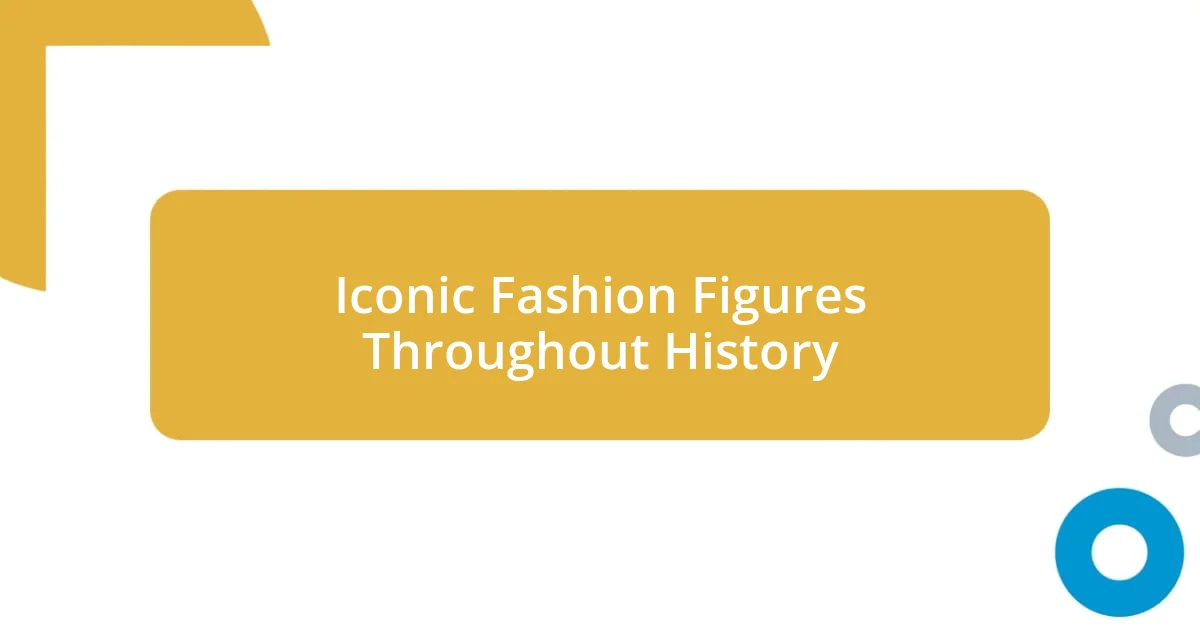
Iconic Fashion Figures Throughout History
When I think of iconic fashion figures, Coco Chanel immediately comes to mind. Her revolutionary approach to women’s fashion in the early 20th century introduced practicality mixed with elegance, freeing women from corsets with her famous little black dress and tweed suits. I remember the first time I slipped on a Chanel-inspired jacket; it was empowering to feel chic and comfortable in a way that echoed the spirit of liberation she championed.
Then there’s the indomitable influence of Audrey Hepburn, whose timeless style in films like “Breakfast at Tiffany’s” transformed how femininity was portrayed on screen. Her elegance and simplicity resonate with me deeply; I often find myself reaching for a black turtleneck and pearls when I want to channel her classic charm. Isn’t it fascinating how one person’s style can inspire generations?
Another standout figure is Alexander McQueen, whose bold designs pushed boundaries and challenged conventional beauty. I recall watching one of his shows and being struck by the powerful narratives woven into his collections. It got me thinking—how does fashion serve as a canvas for deeper messages? McQueen’s work taught me that true artistry in fashion isn’t just about what we wear but also about the stories we tell through our clothing.

Analyzing Fashion Through Events
Analyzing fashion through notable events reveals how moments in history leave a lasting imprint on our wardrobes. I can remember when I first learned about the swinging sixties and how that era encapsulated the spirit of rebellion and creativity. The styles from this time—think bold prints, mini skirts, and vibrant colors—not only represented youth culture but also reflected the changing attitudes toward freedom and empowerment. It struck me how closely intertwined fashion is with the collective consciousness of society during pivotal moments.
Consider the impact of the feminist movement on women’s fashion in the 1970s. I distinctly recall coming across articles that outlined how women began to express their newfound independence through their clothing choices. The proliferation of pantsuits and more androgynous styles was a statement; it was about prioritizing comfort and equal representation over traditional femininity. Doesn’t it amaze you how clothing can articulate a movement’s values?
Events like these remind us that fashion isn’t just fabric and stitching—it’s a canvas for storytelling. When I think about the rise of sustainability in recent years, particularly after climate change discussions gained momentum, I see a significant shift. Designers are increasingly leaning towards eco-friendly materials and ethical practices. The connection between fashion and environmental awareness speaks volumes about our changing priorities. Isn’t it interesting how what we wear can signify our values and beliefs in response to broad societal issues?
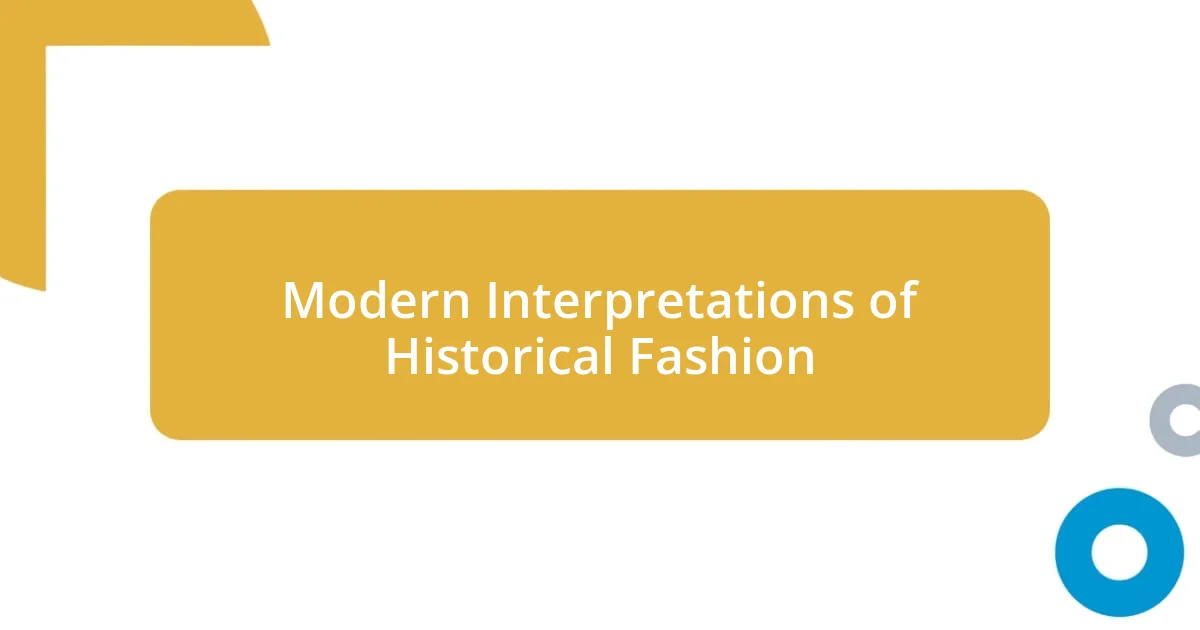
Modern Interpretations of Historical Fashion
Modern fashion thrives on the inspirations drawn from historical styles, often leading to exciting interpretations. I remember shopping for vintage pieces and discovering how current designers reimagined 70s bell-bottoms, infusing them with contemporary flair and sustainable materials. It made me wonder—how can reviving the past create a new narrative in our wardrobes?
Take the resurgence of corsetry in today’s fashion, for instance. Nowadays, designers play with corset shapes, blending them into everyday wear, making them statement pieces that nod to Victorian elegance while ensuring comfort and flexibility. When I put on a modern corset top, I feel a mix of confidence and nostalgia, almost as if I’m wearing a piece of history redefined for today’s world. Doesn’t it speak volumes to how fashion continuously evolves while still paying homage to its lineage?
As we delve deeper into these modern interpretations, it’s intriguing to notice how cultural influences shape fashion choices. I often find myself drawn to designs that incorporate elements from various cultures, like a kimono-inspired jacket that brings a touch of tradition into my casual outfits. How amazing is it that today’s fashion can cultivate a dialogue between centuries, showcasing a blend of cultures and histories through a single garment? This fusion not only enriches our wardrobe but also fosters greater appreciation for global heritage.
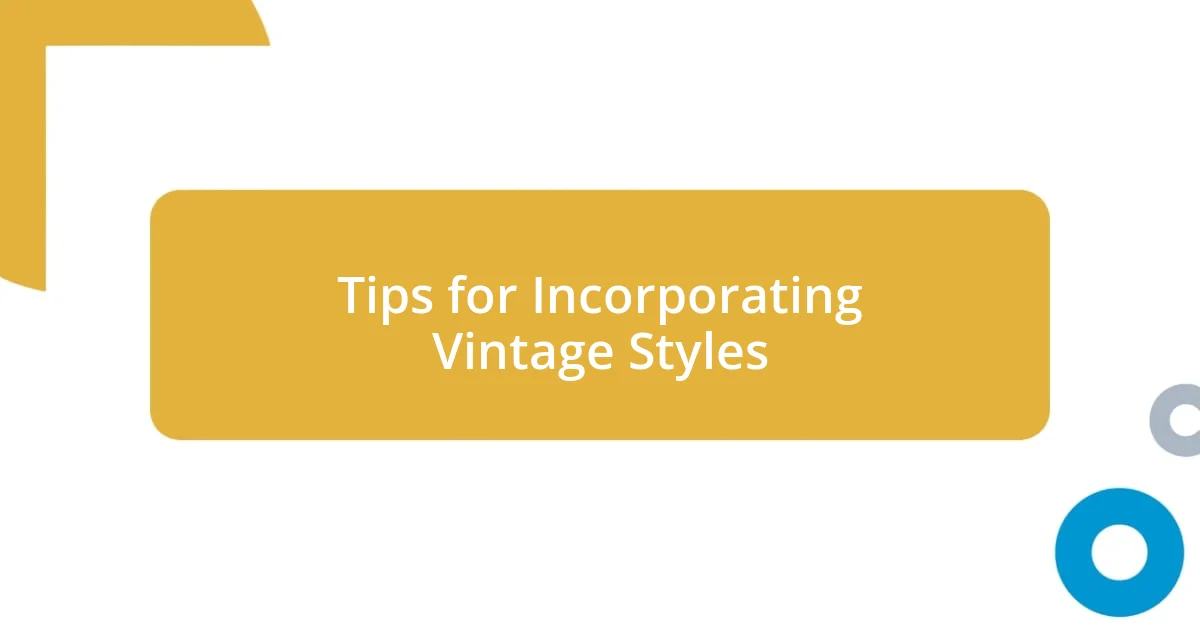
Tips for Incorporating Vintage Styles
Incorporating vintage styles into your wardrobe can be a creative and personal journey. I remember the first time I added a vintage brooch to my outfit; it felt like a secret handshake with the past. By choosing a few standout vintage accessories, like jewelry or bags, you can instantly elevate your look without overwhelming your modern pieces. Have you ever tried mixing an old-time piece with something new? It’s amazing how a simple accessory can spark conversations and allow you to express your unique style.
When I dive into vintage stores, I often seek out pieces that tell a story, like a classic 1940s dress with delicate embroidery. Each time I wear it, I feel a connection to a different era, and it always draws compliments. To channel vintage while feeling contemporary, I’ve found that pairing these timeless pieces with modern items, like trendy sneakers or a stylish denim jacket, creates a delightful balance. Isn’t it fun to take fashion history into your own hands and make it vibrant for today?
Experimenting with vintage cuts can also add that signature flair to your wardrobe. I once tailored a vintage pea coat to better fit my silhouette, and it became one of my favorite pieces. Playing with flattering fits, like high-waisted trousers or A-line skirts, honors the past while ensuring you feel confident and comfortable today. Have you considered how tailoring vintage finds can breathe new life into them? It’s like transforming a beloved relic into something that feels authentically you!












